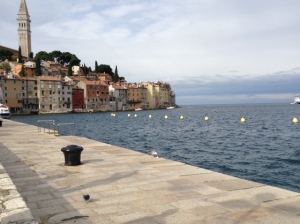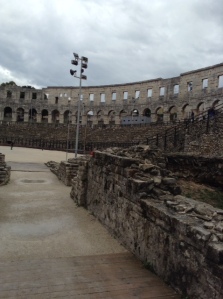On a sad note, as I write this post, it is less than three days since the terrifying events in Paris took place. Paris is our favourite travel destination and some of the attacks took place only a kilometre or so from the hotel in the Marais district where we have stayed on three occasions. The hotel’s employees are in our thoughts. We have booked to stay there again next year and we remain committed to doing just that. Vive le France!
From Zagreb, our tour coach driver, Robert took us west, and we soon reached the border of Croatia and Slovenia. Although both Croatia and Slovenia are members of the European Union, the border was neither invisible nor, without passports being checked, permeable (see comment by Urska, below). There was even a group of tents set up, to accommodate any Middle Eastern refugees who made it across Croatia as far as the Slovenian border.
Immigration control behind us, we crossed an agricultural region, climbed into some hilly country and reached our destination – the famous Postojna caves. I won’t fill up space here with information about this massive cave system that is readily available on the internet.
With an allocated entry time, we joined numerous other visitors on a rollocking 5km journey by train into the heart of the caves, followed by a series of walks on an up-and-down path. There were occasional stops to listen to the guide explain and point out various features, using a microphone linked to an installed PA system; it was not easy to hear if you were at the back of the throng. The path was damp but safe – sand embedded in a concrete base – but it was a taxing exercise. Maggie, with a dodgy knee, struggled, as did others in our tour group.
I found the experience very stimulating but I also felt that the guided-walking phase of the operation was not quite as user-friendly as it could have been. That said, the planning and investment that has been undertaken to provide safe access to the heart of the cave system, without compromising its integrity, is genuinely impressive.
From the caves, we headed south and soon re-entered Croatia. Our hotel for the next two nights was in the leafy, Italianate town of Opatija, on the north-east coast of the Istra Peninsula. There was plenty of time before the evening meal to explore the town, including its long, seaside promenade.
Next morning, Robert drove us across the peninsula to Rovinj, a port town established by the Romans and, much later, controlled by Venice for more than five hundred years. It is a very attractive and lively town, with a small but busy produce market, numerous cafes doing a roaring trade in espressos and Italian-style cakes, a plethora of restaurants and a built environment that reflects its Venetian associations.
During some free time, we had our first Adriatic seafood meal. It was varied and delicious, the first of many such experiences!
After lunch, we travelled south to Pula, at the southern end of the Istra Peninsula. Pula was an important centre during Roman times, then flourished again as a base for the Byzantine naval fleet. Centuries of subsequent decline ended in the mid-19th Century, when it became the main naval base of the Austrian empire – yes, it’s where Captain von Trapp served – and it has a similar function in modern Croatia. All we saw of Pula was its large Roman amphitheatre, which has been restored sufficiently to be used as a concert venue. It was a cool, drizzly afternoon, and we have been spoilt by our visit to Rome in 2008, so it didn’t impress us so much. For us, Rovinj was the day’s highlight.
It was overcast again next morning, as we left the Istra Peninsula and travelled along the rugged coast south of the industrial port city of Rijeka. Here we were introduced to the Bora, a cold, dry wind that blows from the north-east at up to 300 kmh. Its destructive force is revealed in the barren areas of land, facing the wind’s path, on the numerous islands off the Croatian coast. We were to experience the Bora first-hand, later in our tour.
By mid-morning, Robert was taking us inland, up into the long Kapela mountain range. As he did so, the weather began to close in, ominously. We were headed for Plitivice National Park, famous for its vast system of lakes and waterfalls. Soon, we were driving through heavy rain. It was still bucketing down when we arrived at our hotel for a sandwich lunch, ahead of our guided walk through some of the park’s most spectacular areas.
The rain was not good news: some sections of the park had been closed for safety reasons; some of the route was along raised timber paths – devoid of handrails – over water bodies (see example below); and there was a lot of water on the the ground-level gravel paths. Maggie was one of those who chose safety first and stayed behind.
By the time our guided walk began, the rain had eased; but there was plenty of water dropping from the foliage to fill the gap! It was a long, exacting walk, but a rewarding one. Much of the scenery was genuinely beautiful and it would have been even more so in fine weather. I was sorry that Maggie had missed out but, given her knee and ankle problems, it would have been too dangerous. I shot a few videos on my iPhone to give her a taste of the sounds to go with the images.
On a happier personal note, Maggie sent a postcard from Plitvice to her daughter and grandchildren, back in Melbourne. It turns out that the woman, a Croat, who cleans the family home became engaged while standing under the largest waterfall at Plitvice, and she was very excited to find the postcard displayed in Jenny’s kitchen after it arrived. With travel, positive connections often come.

























I’m sorry, but you’ve got some facts wrong and couldn’t resist correcting you. 😉 Firstly, Slovenia is member of European Union and is also part of Schengen Area. Croatia is also a European Union member, but is not part of Schengen area (that’s the reason for border control). Secondly, Postojna cave is not inscribed on UNESCO World Heritage list.
LikeLike
Thank you Urska. My memory failed me in relation to the EU. We also visited Montenegro, which is not an EU member but, just to confuse things, is in the Euro zone. And I was just plain wrong re UNESCO. I will amend the post.
LikeLiked by 1 person
No worries, we all make mistakes. Europe is so small and diverse, you can mix things easily. 😉
LikeLike